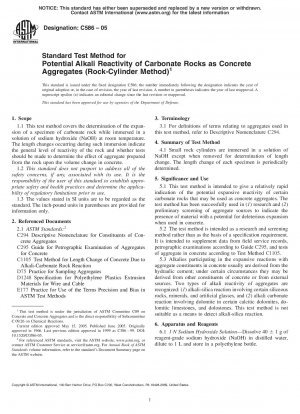ASTM C586-05
Standard Test Method for Potential Alkali Reactivity of Carbonate Rocks as Concrete Aggregates (Rock-Cylinder Method)
- Standard No.
- ASTM C586-05
- Release Date
- 2005
- Published By
- American Society for Testing and Materials (ASTM)
- Status
- Replace By
- ASTM C586-11
- Latest
- ASTM C586-19
- Scope
This test method is intended to give a relatively rapid indication of the potential expansive reactivity of certain carbonate rocks that may be used as concrete aggregates. The test method has been successfully used in (1) research and (2) preliminary screening of aggregate sources to indicate the presence of material with a potential for deleterious expansion when used in concrete.
The test method is intended as a research and screening method rather than as the basis of a specification requirement. It is intended to supplement data from field service records, petrographic examinations according to Guide C 295
, and tests of aggregate in concrete according to Test Method C 1105 . Alkalies participating in the expansive reactions with aggregate constituents in concrete usually are derived from the hydraulic cement; under certain circumstances they may be derived from other constituents of concrete or from external sources. Two types of alkali reactivity of aggregates are recognized: (1) alkali-silica reaction involving certain siliceous rocks, minerals, and artificial glasses, and (2) alkali carbonate reaction involving dolomite in certain calcitic dolomites, dolomitic limestones, and dolostones. This test method is not suitable as a means to detect alkali-silica reaction.
1.1 This test method covers the determination of the expansion of a specimen of carbonate rock while immersed in a solution of sodium hydroxide (NaOH) at room temperature. The length changes occurring during such immersion indicate the general level of reactivity of the rock and whether tests should be made to determine the effect of aggregate prepared from the rock upon the volume change in concrete.
1.2 This standard does not purport to address all of the safety concerns, if any, associated with its use. It is the responsibility of the user of this standard to establish appropriate safety and health practices and determine the applicability of regulatory limitations prior to use.
1.3 The values stated in SI units are to be regarded as the standard. The inch-pound units in parentheses are provided for information only.
ASTM C586-05 Referenced Document
- ASTM C1105 Standard Test Method for Length Change of Concrete Due to Alkali-Carbonate Rock Reaction
- ASTM C294 Standard Descriptive Nonmenclature for Constituents of Concrete Aggregates
- ASTM C295 Standard Guide for Petrographic Examination of Aggregates for Concrete
- ASTM D1248 Standard Specification for Polyethylene Plastics Molding and Extrusion Materials
- ASTM D75 Standard Practice for Sampling Aggregates
- ASTM E177 Standard Practice for Use of the Terms Precision and Bias in ASTM Test Methods
ASTM C586-05 history
- 2019 ASTM C586-19 Standard Test Method for Potential Alkali Reactivity of Carbonate Rocks as Concrete Aggregates (Rock-Cylinder Method)
- 2019 ASTM C586-11(2019) Standard Test Method for Potential Alkali Reactivity of Carbonate Rocks as Concrete Aggregates (Rock-Cylinder Method)
- 2011 ASTM C586-11 Standard Test Method for Potential Alkali Reactivity of Carbonate Rocks as Concrete Aggregates (Rock-Cylinder Method)
- 2005 ASTM C586-05 Standard Test Method for Potential Alkali Reactivity of Carbonate Rocks as Concrete Aggregates (Rock-Cylinder Method)
- 1999 ASTM C586-99 Standard Test Method for Potential Alkali Reactivity of Carbonate Rocks for Concrete Aggregates (Rock Cylinder Method)
